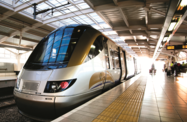A much-needed, multi-billion rand investment programme – spearheaded by Transnet’s capital upgrades and targeting South Africa’s transport bottlenecks – looks set to transform the country’s rail and port services, although historical issues over project delivery and pressure on the government fiscus have made its implementation a more complicated prospect.
According to February budget statements from the minister of finance, Pravin Gordhan, there will be an estimated R4.5trn ($562bn) in financing required for infrastructure projects over the medium term, with roughly R845bn ($105.5bn) already budgeted for. This extensive outlay forms part of the government’s broader plans to modernise the country’s infrastructure and are also in line with its bid to promote export competitiveness and public transport – particularly train travel, which it hopes will reinvigorate both passenger and cargo volumes.
The initiatives are set to create thousands of jobs and will also benefit the country’s industrial and manufacturing sector, which has struggled in recent years with lengthening transit times, congestion and insufficient energy supply. However, the government has a track record of under-utilising funds for new capital projects and haphazard project delivery, which could weaken the full impact of the infrastructure spend.
A large portion of the R845bn ($105.5bn) that has been budgeted – roughly R677bn ($84.5bn) – comes from state-owned enterprises (SOEs). The state-owned transport and logistics company Transnet unveiled its R300bn ($37.9bn) capital investment programme in April, which earmarked R205bn ($25.9bn) for rail developments. Among its targets, the initiative aims to raise freight rail from its current volume of 200m tonnes to 350m tonnes by 2019, creating 500,000 new jobs in the process.
The company plans to finance R213.6bn ($26.9bn) of the scheme from operating cash flows, with the remaining funds to be raised on debt capital markets. It will also allocate R7.7bn ($972,500) to be spent on training and skills development over the next seven years.
The expansion of the cargo rail network and rolling stock is being mirrored in the passenger rail sector, spearheaded by the fleet renewal programme recently announced by the Passenger Rail Association of South Africa (PRASA).
In April, the minister of transport, Sibusiso Ndebele, invited firms to submit bids for the construction of 7224 commuter rail coaches over the course of 20 years valued at R123bn ($15.5bn). PRASA also intends to build new rail signalling and train depots, valued at R15.5bn ($1.9bn), and develop high-density commuter stations worth R25.9bn ($3.3bn) over a three-year period.
The fleet renewal programme, described by PRASA’s group CEO, Lucky Montana, as the largest national project of its kind, looks set to create around 65,000 new jobs. It should also benefit local industry through the introduction of a 65% localisation target that obliges manufacturers to invest and establish a manufacturing base in South Africa by 2016.
The infrastructure upgrades in the rail sector fit within the government’s broader attempts to address some of the structural and cyclical weaknesses of the economy, including most notably industrial competitiveness and unemployment. The overhaul earmarked for South Africa’s rail system will be of key interest to exporters, including mining companies, who are currently saddled with the significant costs that come from using roads for transportation. Rail development should also hugely improve South Africa’s public transport network, which forms a key component in the government’s efforts to address the country’s economic inequalities.
“Our transport policy is about promoting public transport over private car use,” Ndebele said at the opening of the procurement processes. “The policy also seeks to reduce the costs of transport for poor and middle-income households, with the poor still carrying the burden of an inefficient transport system, rooted in the geography of apartheid, where the majority continues to live far from places of work.”
Concerns remain, however, about its history of poor utilisation of infrastructure funds. During his February budget speech, Gordhan noted that under-spending of infrastructure budgets across all levels of government was a serious concern for the industry and that in 2010/11, only R177bn ($22.4bn) of the R266bn ($33.6bn) allocated budget was spent, and that of those projects that were actually launched, cost over-runs were common.
The need to address these constraints is crucial, given the impact infrastructure bottlenecks have on an economy that is grappling with stubborn unemployment rates and low industrial production. South Africa is looking to increase output across a variety of secondary sectors to boost job creation, but its recovery from the 2009 recession has been largely driven by domestic consumption.
Export volumes and fixed capital formation is still struggling to surpass pre-crisis levels, but should the infrastructure programme be implemented in a timely fashion, it will help underwrite a significant boost in GDP growth.

